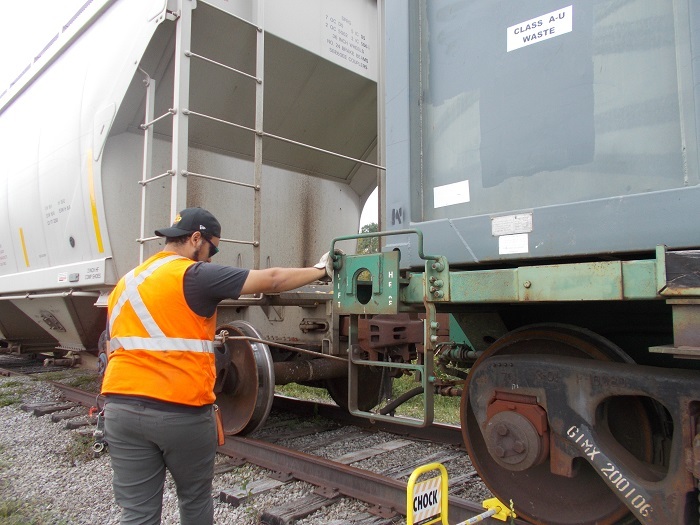 A railroad engineer prepares a shipment of demolition waste from the West Valley Demonstration Project prior to it leaving the site en route to a disposal facility. The first shipment of 12 waste containers from the site’s Main Plant Process Building demolition was filled with debris from the ongoing teardown. Shipping the waste by rail enhances safety by reducing vehicle traffic associated with completing the shipments via truck.
WEST VALLEY, N.Y. – EM and its cleanup contractor at the West Valley Demonstration Project (WVDP) have successfully shipped the first 12 containers of waste from the demolition of the Main Plant Process Building by rail to a disposal facility.
Crews with CH2M HILL BWXT West Valley (CHBWV) expect to ship approximately 1,500 containers of waste from the building takedown over the course of the project, which is scheduled for completion in 2025. The demolition project further reduces environmental risks and positions the site for the next phase of cleanup.
“The rail line is being used for the deconstruction of the Main Plant Process Building and future cleanup work at the site,” EM WVDP Main Plant Project Director Stephen Bousquet said. “This rail line represents a better method for waste disposition that’s safer and more efficient. It will help to accelerate remediation efforts in the future.”
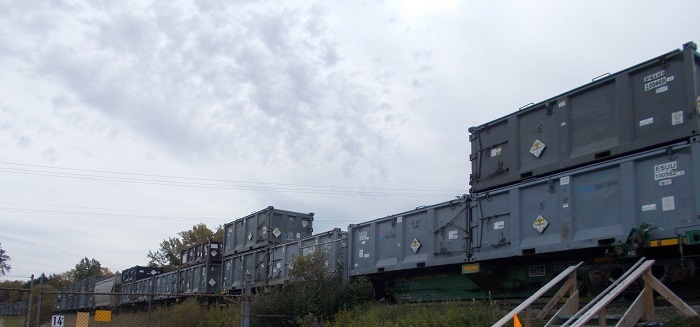 The first shipment of waste for disposal from the demolition of the Main Plant Process Building departs the West Valley Demonstration Project.
Officials with WVDP made a splash at the National Cleanup Workshop last month when they came on stage to make a surprise announcement that workers had launched the teardown of the Main Plant, fulfilling an EM 2022 priority.
Shipping the demolition waste by rail enhances safety by reducing vehicle traffic associated with completing the shipments via truck. Train shipments increase efficiency by allowing more material to be shipped at once compared to trucking. The train shipments also cost less than truck shipments, saving taxpayer dollars.
The site previously worked with the Buffalo & Pittsburgh Railroad (BPRR) Administration to rehabilitate the Western New York Nuclear Service Center rail spur and BPRR’s main line prior to its use.
The EM workforce at WVDP conducted significant work over the past two decades to prepare the five-story, 35,100-square-foot reinforced concrete Main Plant for demolition in a manner protective of human health and the surrounding environment. Employees safely reduced radioactivity in the facility by over 98% by removing more than seven miles of contaminated piping and over 50 tons of contaminated equipment.
From 1966 to 1972, the Main Plant operated as a commercial reprocessing facility to recover reusable plutonium and uranium from spent nuclear reactor fuel. During that period, approximately 640 metric tons of irradiated nuclear fuel was processed.
-Contributor: Joseph Pillittere
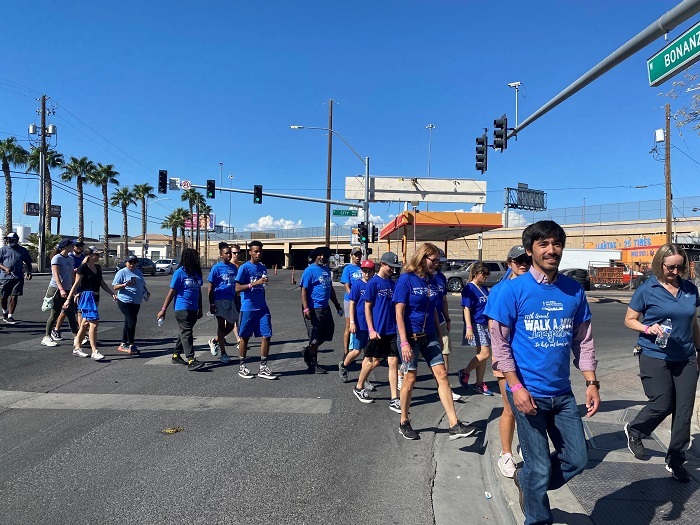 EM Nevada team member Joe Martin leads a group of walkers participating in a fundraiser for the Las Vegas Rescue Mission in Las Vegas.
LAS VEGAS – Garfield Wolfe stood in front of a cadre of EM Nevada Program employees at the Las Vegas Rescue Mission recently and told how the downtown Las Vegas homeless shelter helped turn around his life.
Years earlier, Wolfe said, he was in and out of jail in southern Nevada and struggling with addiction. But when Wolfe got enrolled in the rescue mission’s addiction recovery program, everything started to change for the better.
“I am forever grateful. After I finished the program, the mission hired me to work here. I am now at UNLV working on my bachelor’s degree,” Wolfe said, referring to the University of Nevada, Las Vegas.
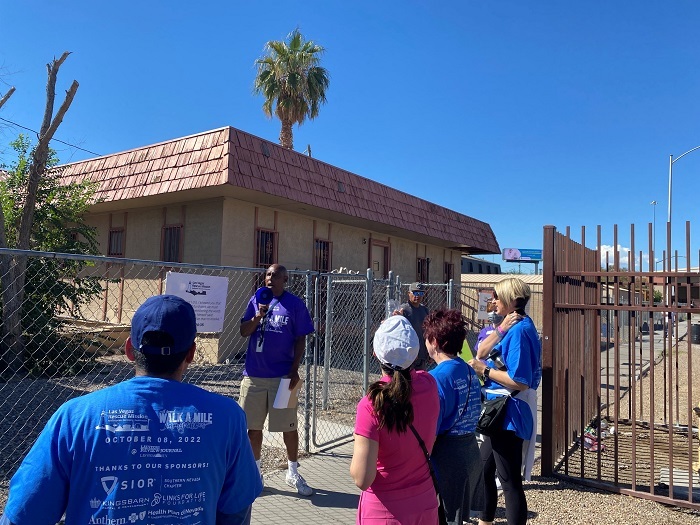 Garfield Wolfe offers a tour of the Las Vegas Rescue Mission in Las Vegas. The tour was part of a fundraiser for the homeless shelter supported by EM Nevada.
Wolfe spoke to the EM Nevada team members — including employees with environmental program services contractor Navarro Research & Engineering — as the group participated in the Las Vegas Rescue Mission’s Walk a Mile in My Shoes fundraiser. The group walked a mile along Bonanza Road in Las Vegas with more than 100 other Las Vegans in an endeavor that raised more than $126,000 for the shelter that provides addiction recovery, emergency housing and meals to those in need.
“It is a great opportunity to support the community,” said Ryan Dodd, Navarro’s industrial sites manager. “We can give back in a way that directly impacts where our office building is in this part of Las Vegas. It shows continued community support for Las Vegas and the needs of the southern Nevada area where we reside.”
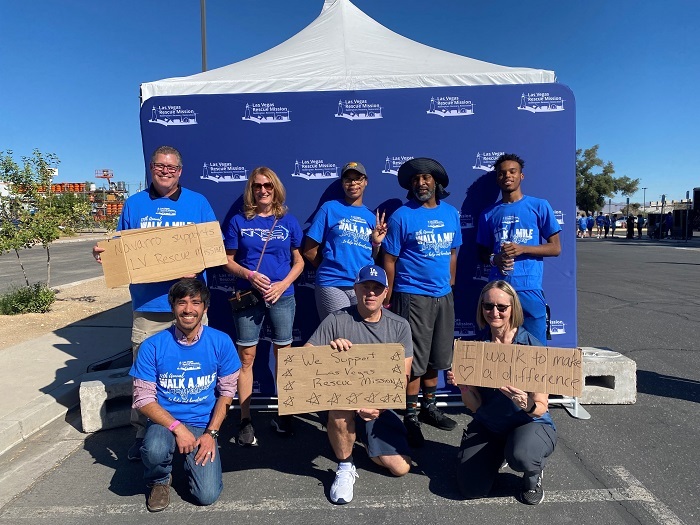 Team Navarro: Back row, from left, Ryan Dodd, Cheryl Hebner, Asia Parker, Byron Smith and Akindred Parker; front row, from left, Joe Martin, Glenn Puit and Barbara Ulmer. Not pictured: Camille Martin, photographer.
Participants in the fundraiser made the walk, then toured the shelter and learned about the faith-based services provided. They even helped prepare a meal and wrote personal notes of encouragement for the men, women and children who benefit from the shelter’s services.
“We really just want to create awareness about the problem of homelessness and also raise funds to provide the services for the people,” said Heather Williams, director of development at the shelter.
Barbara Ulmer, who serves as Navarro’s community commitment plan coordinator, said helping out the shelter was a rewarding experience for all who participated.
"The funds Team Navarro raised will feed 115 people in need, give relief for two nights for a family of three and provide two nights of shelter for those in need in our community." Ulmer said.
-Contributor: Glenn Puit
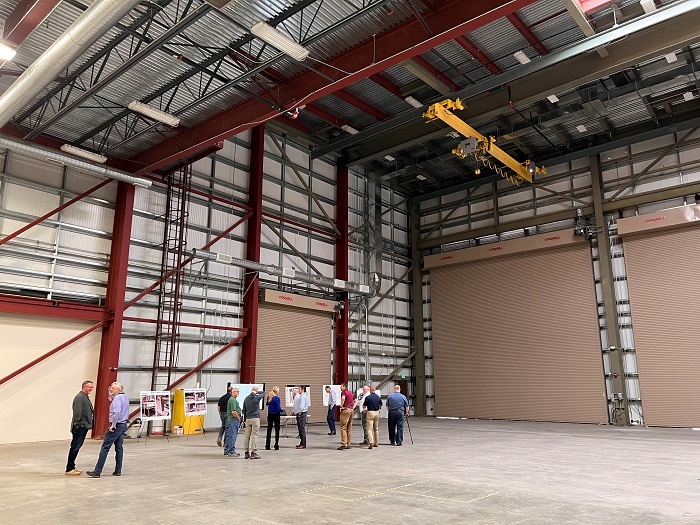 The Low-Activity Waste Melter Assembly, Storage and Transportation facility near the Hanford Site is a repurposed building that was retrofitted and expanded to support the assembly of 300-ton melters for the Waste Treatment and Immobilization Plant.
RICHLAND, Wash. – EM Office of River Protection (ORP) tank operations contractor Washington River Protection Solutions (WRPS) is ready to begin assembling additional melters to support the Direct-Feed Low-Activity Waste (DFLAW) Program at the Hanford Site.
“The melters are the heart of DFLAW, making it vital to have replacements assembled and ready to change out the first set of melters when they reach the end of their expected lifespans,” said Delmar Noyes, ORP assistant manager for Tank Farms Project. “This will ensure the continuity of glass immobilization operations and provide cleanup progress on the Hanford Site.”
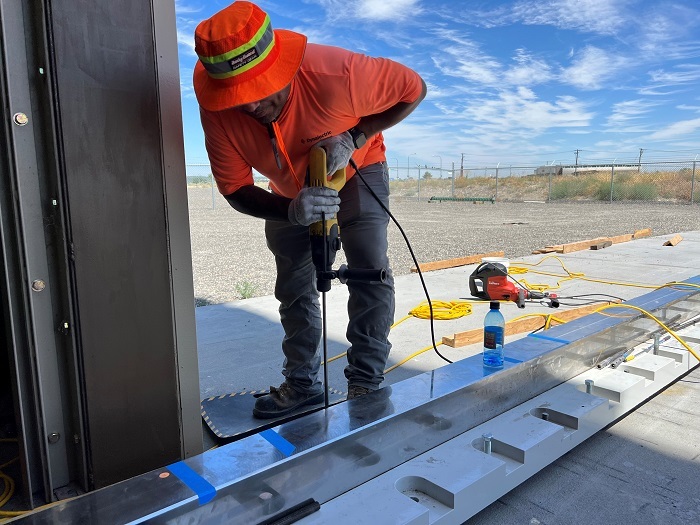 Vince Bass, journeyman carpenter with subcontractor Fowler General Construction, installs one of two rails at the Low-Activity Waste Melter Assembly, Storage and Transportation facility in Richland, Washington, near the Hanford Site. The steel rails will be used to move the 300-ton melter shells into the facility where they will be fitted with the components needed to heat up the waste and glass-forming materials.
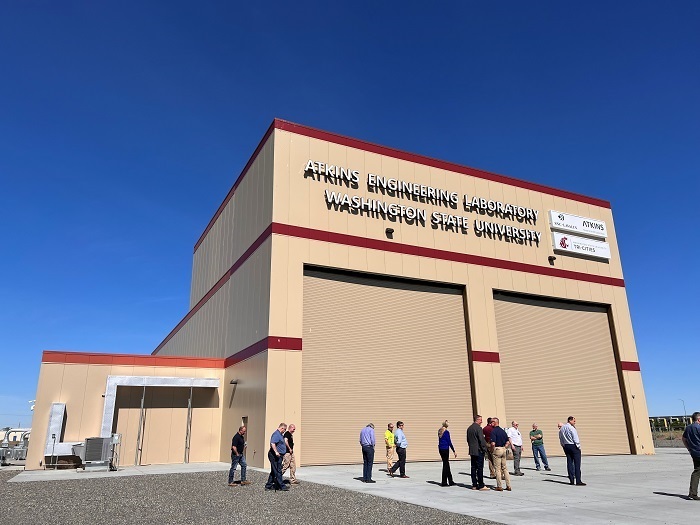 Representatives from the Office of River Protection and broader DOE tour the Low-Activity Waste Melter Assembly, Storage and Transportation facility near the Hanford Site prior to the installation of steel rails outside of the bay doors.
ORP contracted with WRPS to assemble two spare melters at an offsite location in addition to procuring critical replacement parts to support Waste Treatment and Immobilization Plant (WTP) operations at Hanford. Replacement melters cannot be assembled at WTP once waste treatment has started because assembly can take up to two years.
“We worked closely with the Department and WTP staff to identify the parts critical to continued operation of the Low-Activity Waste (LAW) Facility in the post-commissioning phase,” said Allan Exley, program manager of WTP operational spares at WRPS.
Two melters inside the WTP will vitrify, or immobilize in glass, radiological and chemical tank waste left over from plutonium production during World War II and the Cold War. WTP contractor Bechtel National Inc. assembled the first two 300-ton melters inside the WTP.
In September, WRPS installed a set of high-capacity transport rails at its assembly and storage facility near Hanford. The steel rails will transport and hold melter parts for assembly and storage until new melters are needed to replace the existing ones at WTP. Each melter has an expected lifespan of about five years. The replacement melter assembly is expected to begin shortly after the first set of outer shells for replacement melters are delivered to the facility next year.
-Contributor: Jenna Kochenauer
 Savannah River Mission Completion (SRMC) Cybersecurity Analyst Christopher Walker, center, collaborates with SRMC cyber team members Jim Anderson, left, and Sean Nixon during an annual security assessment audit.
AIKEN, S.C. – EM’s liquid waste contractor at the Savannah River Site (SRS) has been named a champion of cybersecurity awareness for ensuring its people and programs stay safe online.
As a 2022 National Cybersecurity Alliance Cybersecurity Awareness Month Champion,
Savannah River Mission Completion (SRMC) is committed to cybersecurity protection and best practices.
Cybersecurity is a critical component of DOE missions, according to Lewann Belton, DOE-Savannah River Cyber and Information Technology Division manager.
“Defending cybersecurity systems is essential to EM’s mission, and I appreciate the support that the site’s contractors provide for our cyber programs,” Belton said. “Savannah River Mission Completion earning the champion status of National Cybersecurity Awareness Month shows SRMC is committed to safeguarding DOE information systems.”
Cybersecurity Awareness Month, recognized every October, is designed to engage and educate organizations through events and initiatives to increase the resiliency of the nation against potential cyber incidents. The champions represent those dedicated to promoting a safer, more secure and more trusted internet.
This year, the Cybersecurity Awareness Month focus areas are four fundamental cybersecurity best practices: enabling multi-factor authentication, using strong passwords and a password manager, updating software, and recognizing and reporting phishing.
SRMC Cybersecurity Analyst Christopher Walker said the SRMC cyber team works closely with information technology and cyber professionals across SRS, defending business systems, as well as industrial control systems from all angles.
“The breadth of our scope is large,” Walker said. “It is crucial for us to pay attention to all aspects of cyber safety, from ensuring users’ government-issued mobile devices stay updated to safeguarding electronic control systems within our liquid waste facilities.”
The non-profit National Cybersecurity Alliance works to create a more secure, interconnected world. The group advocates for the safe use of all technology and educates users on how best to protect themselves, families and organizations from cybercrime.
-Contributor: Colleen Hart
|